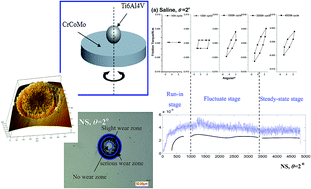Effect of angular displacement amplitude on the torsional fretting corrosion behavior of CoCrMo alloy in different synovial fluid
Abstract
The T–θ curves, friction torque curves, impedance and morphology were measured to research the effect of angular displacement amplitude on the torsional fretting corrosion behavior of the CoCrMo alloy in different synovial fluids. The results showed that the torsional fretting process could be divided into a running-in stage, a fluctuate stage and a steady-state stage both in NS and FBS. When the friction process was stable, the twisting fretting process of CrCoMo alloy was in the partial slip stage at θ = 2° and in the gross slip stage at θ = 6°, and the friction energy dissipation increased with the increase of θ. The results of electrochemical impedance spectroscopy showed that the impedance of the CoCrMo alloy decreased with the increase of θ, and when θ was larger, the decrease of impedance was more obvious. Also, the decrease of impedance in FBS was more obvious than that in NS. The surface roughness of CoCrMo after wear was enlarged with the increase of θ. The wear zone was extended to the central parts from the edge of the contact area, and wear was also severe in the central parts at a large value of θ. In NS, there was an obvious curved furrow at the edge of wear zone, and the roughness was much larger than that in FBS.


 Please wait while we load your content...
Please wait while we load your content...